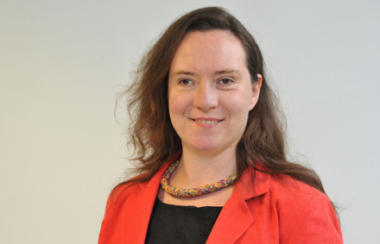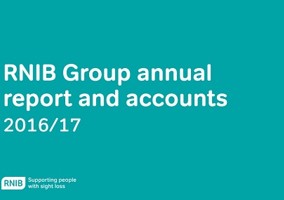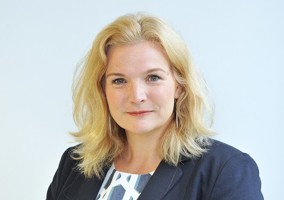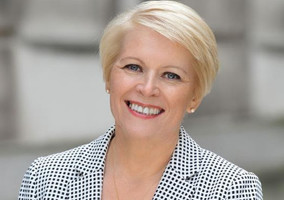RNIB is changing its approach in an attempt to form a much closer connection with its beneficiaries, says its new chair Eleanor Southwood.
Eleanor Southwood was born blind, and RNIB has always been in her life.
But Southwood, who took over last year as chair of the sight loss charity, says she has not always perceived RNIB as relevant to her.
“As a woman in my 20s, I had a feeling the charity didn’t speak for me,” she says. “RNIB was too corporate, too stuffy, and too boring.”
Southwood is still only 35, very young to be a charity chair. She has taken over at a relatively turbulent time – the charity restructured and made redundancies after completing a merger with Action for Blind People; it has a new chief executive, Sally Harvey; and like many big charities it has faced criticism over fundraising and use of donor data.
But Southwood is more focused on the charity’s relationship with its community. She wants blind people to feel that RNIB belongs to them.
“It’s a strange club to belong to,” she says. “No one wants to be a member.”
Southwood’s own involvement with the RNIB came following a chance meeting with Kevin Carey, the previous chair, who invited her onto the board. She became a trustee in 2010 and later became vice chair.
“I felt if I wanted RNIB to speak for people like me, I needed to get involved,” she says.
In the past, she says, RNIB was “an organisation which knew a lot about blindness, but not a lot about blind people”. This is the antithesis of her goal for the organisation.
“We want to create a sense of community,” she says. “We want to be completely driven and led by our community. We’re here to facilitate whatever that community want and need from us.”
No more five-year strategies
Her plan is to ditch five-year strategies in favour of a three-year rolling programme that changes readily with the circumstances, and responds quickly to feedback.
“One of the things we’re doing at the moment is looking at core purposes,” she says. “And being a community convener is at the heart of it. It enables us to do the other things. It allows us to be strong as a campaigner. We want campaigning to be driven by our community. It’s not just about influencing MPs. It’s about private sector organisations. It’s about public attitudes.
“Service delivery is obviously a big part of what we do, but we want to deliver services we’re well placed to do. It’s about capacity building. It’s about being a partner and a friend.
“There are plenty of organisations working to cure blindness. Our job is to help those already suffering from sight loss.”
The change of approach seems likely to play out in how the charity does day-to-day business.
“Moving to a business planning cycle will mean that evolution and change will be more a part of things,” she says. “I don’t want to create more uncertainty than necessary for the people working here, but we need to be sure we’re making the brave decisions and doing what our community needs.
“Some of our services and the ways we’ve worked have not been sustainable. We can’t carry on as we are just because we don’t want to rock the boat.”
Too many sight loss charities
RNIB has always been braver than most when it came to operational issues. Southwood’s predecessors pursued merger enthusiastically because they believed there were too many sight loss charities. Southwood seems less evangelical, but she believes some of the same things.
“I still think there are too many charities for blind people,” she says. “How can someone know what’s available when it’s all so fragmented? I wouldn’t be worried about how many charities there are, if everyone knew who and where they are.”
She is also in favour of payment for trustees. She herself is paid for her role and is currently the only remunerated member of the board. But she would pay other trustees if the situation warranted it.
“If you’re serious about diversity, then pay should be a possibility,” she says. “Most people with sight loss don’t have a job, and we want them to be able to give up their time.”
Southwood says the governance model is changing to meet the needs of the new approach. Once again, she wants to do more to involve the whole community in good governance. She wants fewer formal committees of trustees, and a more relaxed regimen of “second tier groups” focusing on broad themes, with a wider range of stakeholders.
“What we want is to move away from set pieces,” she says. “We don’t want to be leaning heavily on a small number of people. We want governance to be part of the everyday.”
It’s vital, she says, that charity staff are engaged with the goals of the organisation.
“People come to work here because they are passionate and that’s a huge advantage,” she says. “What we need to be clear about is where that advantage should be focused. I think it’s a real challenge that the energy in the sector can sometimes not be focused in the right direction. One of the things that has come through really clearly is that performance management can be challenging. It can be hard to say no to people who have drive and commitment, and to explain to them that the thing they want to do is not the most important thing to achieve right now.”
Fundraising regulation
What about fundraising and regulation? It’s an issue for RNIB. The charity was previously monitored by the Information Commissioner’s Office over its handling of donor data, and took a bullish approach to the establishment of the new Fundraising Regulator. The former chief executive, Lesley-Anne Alexander, held out against paying the levy which funds the regulator for a long time.
It looks like RNIB’s new chair and CEO are more conciliatory, and the charity is working hard on compliance with the regulator and the upcoming General Data Protection Regulation.
“Charities have had a real bashing recently,” Southwood says. “We’ve responded, and we need to be confident in our level of compliance.”
She is keen to highlight that donors are part of the RNIB community she is trying to strengthen, and they must be treated as valued partners.
“It’s a bit artificial to draw a line between donors and beneficiaries and staff and partners,” she says. “You can be part of all groups in different ways. We want to focus on building relationships. Everyone who makes a contribution should be honoured.”
She says the charity is keen to move away from “transactional relationships” and to this end has brought together its marketing, communications and fundraising directorates.
This is part of an increasing trend among big charities, which are interested in aligning the messages they send.
Southwood’s real focus is on communication with all stakeholders on what the charity really wants to achieve, and what it needs to do to achieve it.
“When we have conversations with donors, they understand that we need to spend money on people,” she says. “It’s about being able to speak with confidence about the quality of people we have and what they’re there to do. We need to be less apologetic about paying people.”
She says the key is that everyone who needs to feel connected to the charity.
“We want total immersion,” she says. “We want to be an organisation with a very different personality to the one we had 50 years ago.”
Related articles












